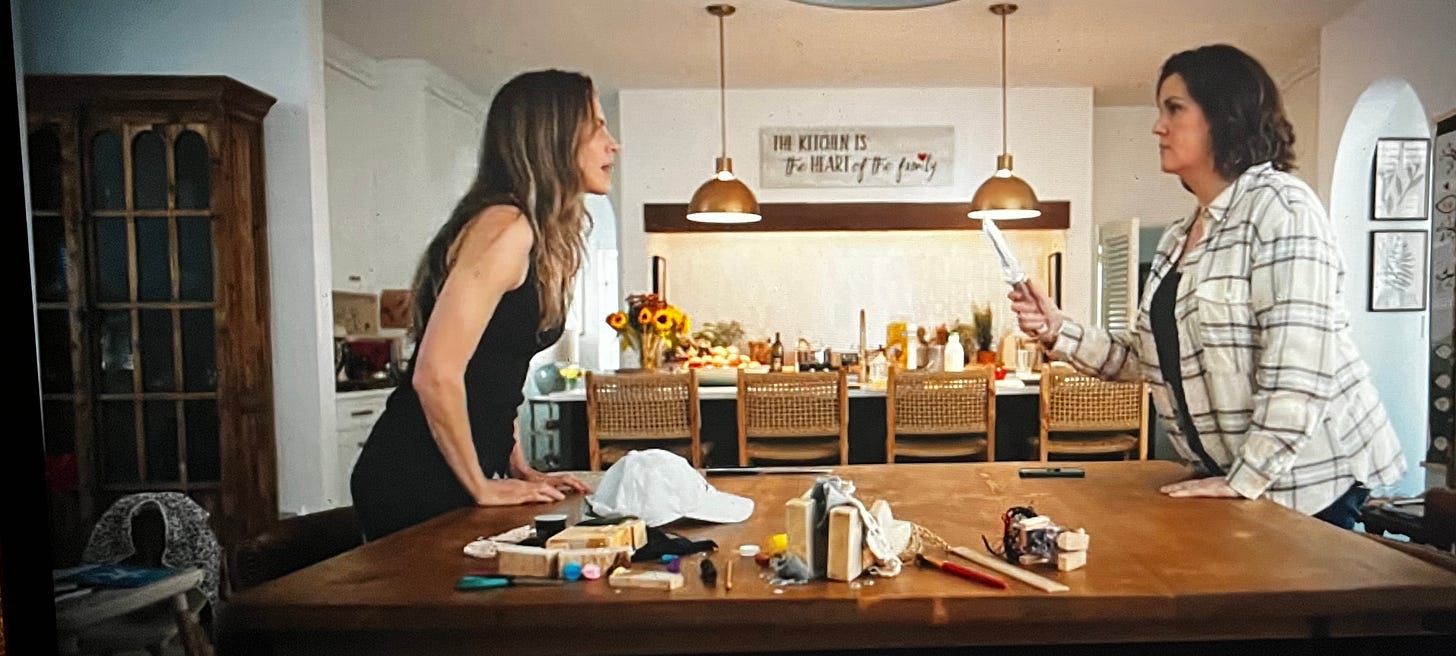On Yellowjackets, the Kitchen Is Decidedly Not the Heart of the Family
Hearts are for eating and breaking on the Showtime drama—and production designer Margot Ready leaned into the irony in Melissa's house.
There is a moment early in Season 3 of Yellowjackets where we can almost believe the kids are alright. The winter of their cannibalistic discontent has passed, leaving them raising livestock and generally living the kind of life every reader of The Boxcar Children series imagined for themselves.
But this is Yellowjackets—the series that opened with an Antler Queen and masked women chasing one of their own into a spike-filled pit. Things never calm down for long, and although the shelters the girls have built for themselves seem cozy and charming, they also convey something else.
“We always try to have a meaning beyond the obvious,” series production designer Margot Ready says. “I was asking the showrunners early on: ‘Do we want to make this really simple or do we wanna have more craft?’ And ultimately they were like, ‘Let's lean towards what is plausible to be built, but also has a style and a meaning and is evocative.’”
Ready ran with that directive in a number of ways, from adding character-specific details (“With Lottie's, I put the circular window in the kind of panopticon because to me, no matter who else is in play, Lottie is at the head of the sundial, as it were. She can look out and see what everybody's doing at any time”) to making sure that the silhouettes could turn sinister.
“That was the hope,” she says. “That at night you're suddenly like, ‘Wow, that's actually a little witchy and scary, but I didn't notice in the daytime 'cause there's flowers growing on it.”
The huts serve as a microcosm of one of the larger themes in Yellowjackets: the ways in which people conceal and obscure their true identities. Adult Shauna has long been the most obvious example—a woman undone by trauma who has been cosplaying as a suburban wife and mother for decades—but this season saw the introduction of another adult Yellowjacket just as skilled at wearing a costume: Melissa.
In one of the series’ all-time great moments, Shauna and Melissa (played with teeth-baring precision by Melanie Lynskey and Hilary Swank) fight to a bloody draw in Melissa’s kitchen, under the baleful gaze of a wine mom sign that reads: The Kitchen Is the Heart of the Family.
The house itself is so benign as to be a model home for a development. “We were very careful to make everything there very not textured,” Ready says. “Her walls are so clean, and every single thing is curated to be, ‘Look who I am. This is my life.’” Which led directly to that sign.
“There was a blank spot on the wall over the stove area, and I was like, ‘Let's put one of those falsely optimistic word signs up there, when people are virtue signaling. If you have to say it that loud…” Ready says. “But also just the heart symbolism and the cannibalism, frankly—it’s a little nod to that. We don't wanna be too obvious or dominate the scene, but there are reasons to do things that are fun for us as well.”
Ready takes full credit for another Easter egg glimpsed in early scenes: an architecture book lying around the compound that helps partially explain how the teens ended up with such well-designed huts.
“These are really simple structures to make,” Ready points out. “You make a circle of stones, and you tip up some branches. I watched our greens team make them in real time. And it was a pitch: Wouldn't it be fun if we had this book [visible]? And then Bart [Nickerson, the co-showrunner], in the first episode, was like, ‘You know what, we're gonna shoot the book.’ And he ended up adding it into the cut, and I'm really glad he did.”
The architecture book was grandfathered into what the team decided everyone salvaged from the plane. “They had their vanity table. There's a couple of burned cups, there's some tools,” Ready says. “We're careful that everything has evidence of its distress. And later we wanted to show the parts that had been peeled away from the airplane when we go back inside. The ceiling panels are pulled down because they used a lot of wire to tie the gates and the fences together. Everything in the village had to be explained. How did you make it? Where did you get it? So we had a lot of conversations about that.”
One thing that didn’t require as many conversations this season? Snow. After famously using up all the fake snow in British Columbia during Season 2, it was just the Season 3 finale that needed it this time. And Ready was prepared for what it would take. “Snow is always a challenge,” she says. “You need to do a lot of it to make it feel real. Definitely, we tried to take what we had learned into this season. And all the snow this season was outside, which is a little bit more straightforward in some ways 'cause at least the daylight gives you a naturalism. But snow is a really fascinating challenge. It's a multi-product system, and it's definitely time-consuming. And our special effects departments are heroes because they're the ones who are really doing the application.”
Margot Ready was the production designer for The Magicians and earned an Art Directors Guild nomination for Excellence in Production Design for Season 2 of Yellowjackets. Her go-to at crafty is “always gum 'cause that's everyone's go-to. But recently, people have been doing these wonderful, healthy chia [seed puddings] with yogurt. I would never make that at home, because it's pretty labor intensive, 'cause you soak the chia seeds for a while, but it's healthy and it tastes amazing. So you feel like you've had a treat.”




